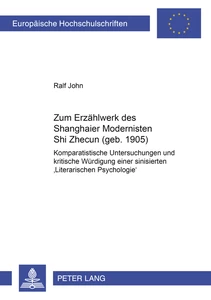results
-
The Modernist Revolution in World Literature
ISSN: 1528-9672
In the stormy time period approximately between the Paris Commune in 1871 and the revolutionary events in May 1968, or between the conclusion of the American Civil War and the withdrawal of American troops from Vietnam, the rise and fall of international modernism was crucial to all historical, political, and intellectual de-velopments around the world. By the time the United States had emerged from its military involvement in Indo-China, the modernist movement had given way to postmodernism. This series investigates the development of international modern-ism in the half century leading up to World War I and its disintegration in the fol-lowing fifty years. High modernism claimed that it represented a break with corrupt values of previous cultural traditions, but we now think that this very drive to make it new is itself derivative. What are the roots and characteristics of modernism? How did the philosophical and pedagogical system supporting modernism develop? Is mod-ernism, perhaps, not a liberating movement but a device to shield high culture from rising democratic vulgarization? What is the role of modernism in postcolonial struggles? Where does feminism fall in the modernist agenda? How do changing systems of patronage and the economy of art influence modernism as an enor-mously expanded reading public becomes augmented by cinema, radio, and televi-sion? Such questions on a worldwide stage, in the century approximately from 1870 to 1970, in all manifestations of literature, art, politics, and culture, represent the scope of this series In the stormy time period approximately between the Paris Commune in 1871 and the revolutionary events in May 1968, or between the conclusion of the American Civil War and the withdrawal of American troops from Vietnam, the rise and fall of international modernism was crucial to all historical, political, and intellectual de-velopments around the world. By the time the United States had emerged from its military involvement in Indo-China, the modernist movement had given way to postmodernism. This series investigates the development of international modern-ism in the half century leading up to World War I and its disintegration in the fol-lowing fifty years. High modernism claimed that it represented a break with corrupt values of previous cultural traditions, but we now think that this very drive to make it new is itself derivative. What are the roots and characteristics of modernism? How did the philosophical and pedagogical system supporting modernism develop? Is mod-ernism, perhaps, not a liberating movement but a device to shield high culture from rising democratic vulgarization? What is the role of modernism in postcolonial struggles? Where does feminism fall in the modernist agenda? How do changing systems of patronage and the economy of art influence modernism as an enor-mously expanded reading public becomes augmented by cinema, radio, and televi-sion? Such questions on a worldwide stage, in the century approximately from 1870 to 1970, in all manifestations of literature, art, politics, and culture, represent the scope of this series In the stormy time period approximately between the Paris Commune in 1871 and the revolutionary events in May 1968, or between the conclusion of the American Civil War and the withdrawal of American troops from Vietnam, the rise and fall of international modernism was crucial to all historical, political, and intellectual de-velopments around the world. By the time the United States had emerged from its military involvement in Indo-China, the modernist movement had given way to postmodernism. This series investigates the development of international modern-ism in the half century leading up to World War I and its disintegration in the fol-lowing fifty years. High modernism claimed that it represented a break with corrupt values of previous cultural traditions, but we now think that this very drive to make it new is itself derivative. What are the roots and characteristics of modernism? How did the philosophical and pedagogical system supporting modernism develop? Is mod-ernism, perhaps, not a liberating movement but a device to shield high culture from rising democratic vulgarization? What is the role of modernism in postcolonial struggles? Where does feminism fall in the modernist agenda? How do changing systems of patronage and the economy of art influence modernism as an enor-mously expanded reading public becomes augmented by cinema, radio, and televi-sion? Such questions on a worldwide stage, in the century approximately from 1870 to 1970, in all manifestations of literature, art, politics, and culture, represent the scope of this series
3 publications
-
Zum Erzählwerk des Shanghaier Modernisten Shi Zhecun (geb. 1905)
Komparatistische Untersuchungen und kritische Würdigung einer sinisierten «Literarischen Psychologie»©2001 Thesis -
Modernist Translation
An Eastern European Perspective: Models, Semantics, Functions©2016 Monographs -
Modernist Visions
Marcel Proust’s «A la recherche du temps perdu» and Jean-Luc Godard’s «Histoire(s) du cinéma»©2012 Monographs -
The Modernist Human
The Configuration of Humanness in Stéphane Mallarmé’s "Herodiade</I>, T. S. Eliot’s "Cats</I>, and Modernist Lyrical Poetry©2008 Monographs -
An Apprehensive Aesthetic: The Legacy of Modernist Culture
The Legacy of Modernist Culture©2009 Monographs -
Beyond the Paradox of the Nostalgic Modernist
Temporality in the Works of J.-K. Huysmans©2004 Monographs -
Structure and Chaos in Modernist Works
©1995 Others -
Freaks in Late Modernist American Culture
Nathanael West, Djuna Barnes, Tod Browning, and Carson McCullers©2006 Monographs -
Freaks in Late Modernist American Culture
Nathanael West, Djuna Barnes, Tod Browning, and Carson McCullers©2024 Monographs -
Norman Mailer and the Modernist Turn
©2016 Monographs -
Mário de Sá-Carneiro, A Cosmopolitan Modernist
Edited Collection -
Groups, Coteries, Circles and Guilds
Modernist Aesthetics and the Utopian Lure of Community©2019 Edited Collection -
The Theater of Trauma
American Modernist Drama and the Psychological Struggle for the American Mind, 1900-1930©2005 Monographs -
Failure: The Humble Narrative of Unsuccessfulness in Late Modernist Fiction
British, Irish and Postcolonial Novels and Stories©2020 Monographs -
Relations
Ethics and the Modernist Subject in James Joyce’s "Ulysses</I>, Virginia Woolf’s "The Waves</I> and Djuna Barnes’s "Nightwood</I>©2006 Monographs -
A Flowering Word
The Modernist Expression in Stéphane Mallarmé, T. S. Eliot, and Yosano Akiko©2000 Monographs























